The Impact of Society on Esther's Mental Illness in The Bell Jar
VerifiedAdded on 2022/12/14
|6
|1557
|405
Essay
AI Summary
This essay provides a detailed analysis of Sylvia Plath's semi-autobiographical novel, *The Bell Jar*, focusing on the protagonist, Esther Greenwood's, struggle with mental illness within the context of the societal expectations of 1950s America. The essay examines how the suffocating social environment, particularly the contradictory and often unattainable standards imposed on women, contributed to Esther's psychological turmoil and eventual breakdown. It explores the impact of double standards, the pressure to conform, and the limited opportunities available to women during this period. The analysis delves into the novel's exploration of themes such as identity, societal expectations, and the challenges faced by women in a patriarchal society. The essay utilizes textual evidence, including quotes from the novel, to support the argument that Esther's mental illness was significantly influenced by the constraints imposed by the society. Furthermore, it highlights the importance of understanding the historical and social context in interpreting Esther's experiences and the novel's enduring relevance.

Running head: ENGLISH
English
Name of the Student
Name of the University
Author Note
English
Name of the Student
Name of the University
Author Note
Paraphrase This Document
Need a fresh take? Get an instant paraphrase of this document with our AI Paraphraser
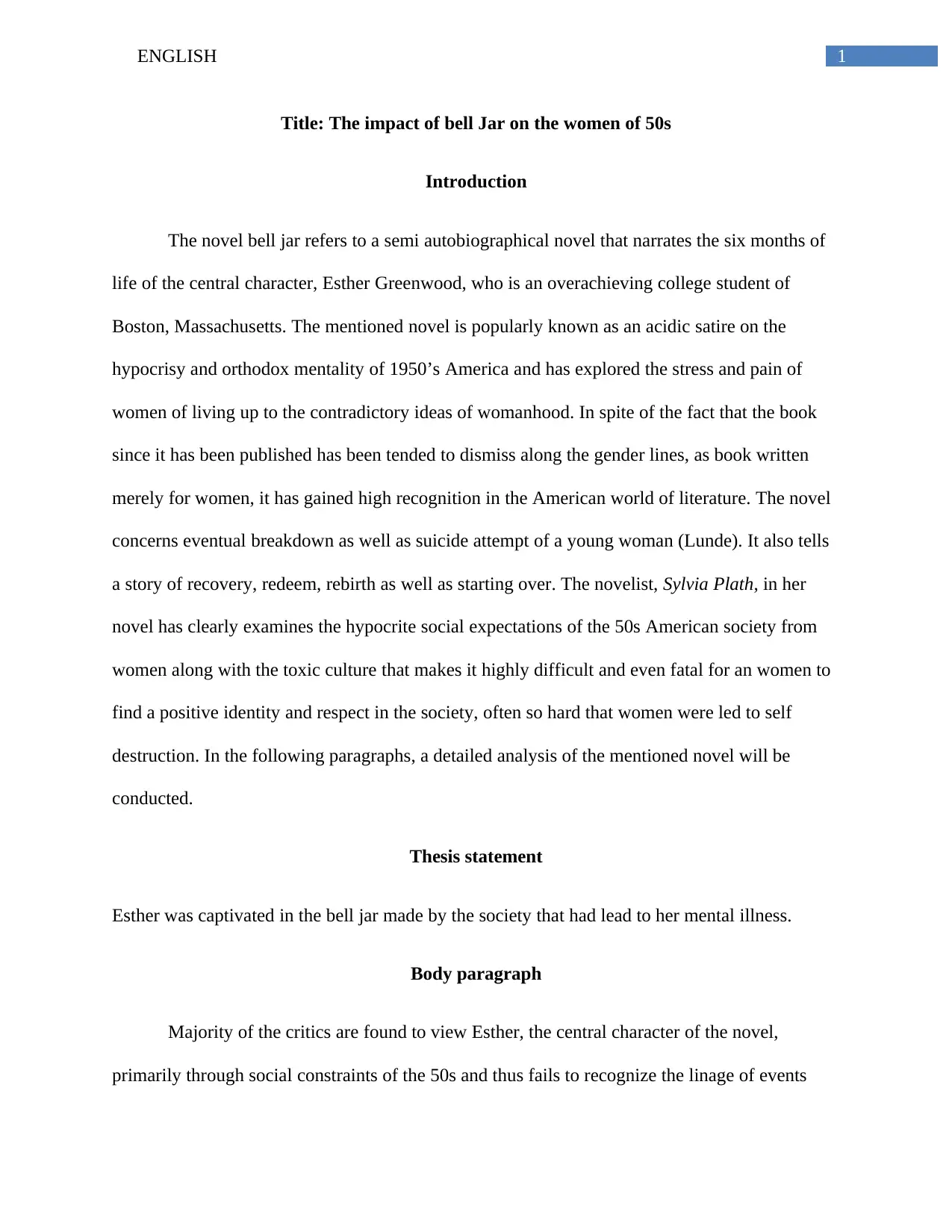
1ENGLISH
Title: The impact of bell Jar on the women of 50s
Introduction
The novel bell jar refers to a semi autobiographical novel that narrates the six months of
life of the central character, Esther Greenwood, who is an overachieving college student of
Boston, Massachusetts. The mentioned novel is popularly known as an acidic satire on the
hypocrisy and orthodox mentality of 1950’s America and has explored the stress and pain of
women of living up to the contradictory ideas of womanhood. In spite of the fact that the book
since it has been published has been tended to dismiss along the gender lines, as book written
merely for women, it has gained high recognition in the American world of literature. The novel
concerns eventual breakdown as well as suicide attempt of a young woman (Lunde). It also tells
a story of recovery, redeem, rebirth as well as starting over. The novelist, Sylvia Plath, in her
novel has clearly examines the hypocrite social expectations of the 50s American society from
women along with the toxic culture that makes it highly difficult and even fatal for an women to
find a positive identity and respect in the society, often so hard that women were led to self
destruction. In the following paragraphs, a detailed analysis of the mentioned novel will be
conducted.
Thesis statement
Esther was captivated in the bell jar made by the society that had lead to her mental illness.
Body paragraph
Majority of the critics are found to view Esther, the central character of the novel,
primarily through social constraints of the 50s and thus fails to recognize the linage of events
Title: The impact of bell Jar on the women of 50s
Introduction
The novel bell jar refers to a semi autobiographical novel that narrates the six months of
life of the central character, Esther Greenwood, who is an overachieving college student of
Boston, Massachusetts. The mentioned novel is popularly known as an acidic satire on the
hypocrisy and orthodox mentality of 1950’s America and has explored the stress and pain of
women of living up to the contradictory ideas of womanhood. In spite of the fact that the book
since it has been published has been tended to dismiss along the gender lines, as book written
merely for women, it has gained high recognition in the American world of literature. The novel
concerns eventual breakdown as well as suicide attempt of a young woman (Lunde). It also tells
a story of recovery, redeem, rebirth as well as starting over. The novelist, Sylvia Plath, in her
novel has clearly examines the hypocrite social expectations of the 50s American society from
women along with the toxic culture that makes it highly difficult and even fatal for an women to
find a positive identity and respect in the society, often so hard that women were led to self
destruction. In the following paragraphs, a detailed analysis of the mentioned novel will be
conducted.
Thesis statement
Esther was captivated in the bell jar made by the society that had lead to her mental illness.
Body paragraph
Majority of the critics are found to view Esther, the central character of the novel,
primarily through social constraints of the 50s and thus fails to recognize the linage of events
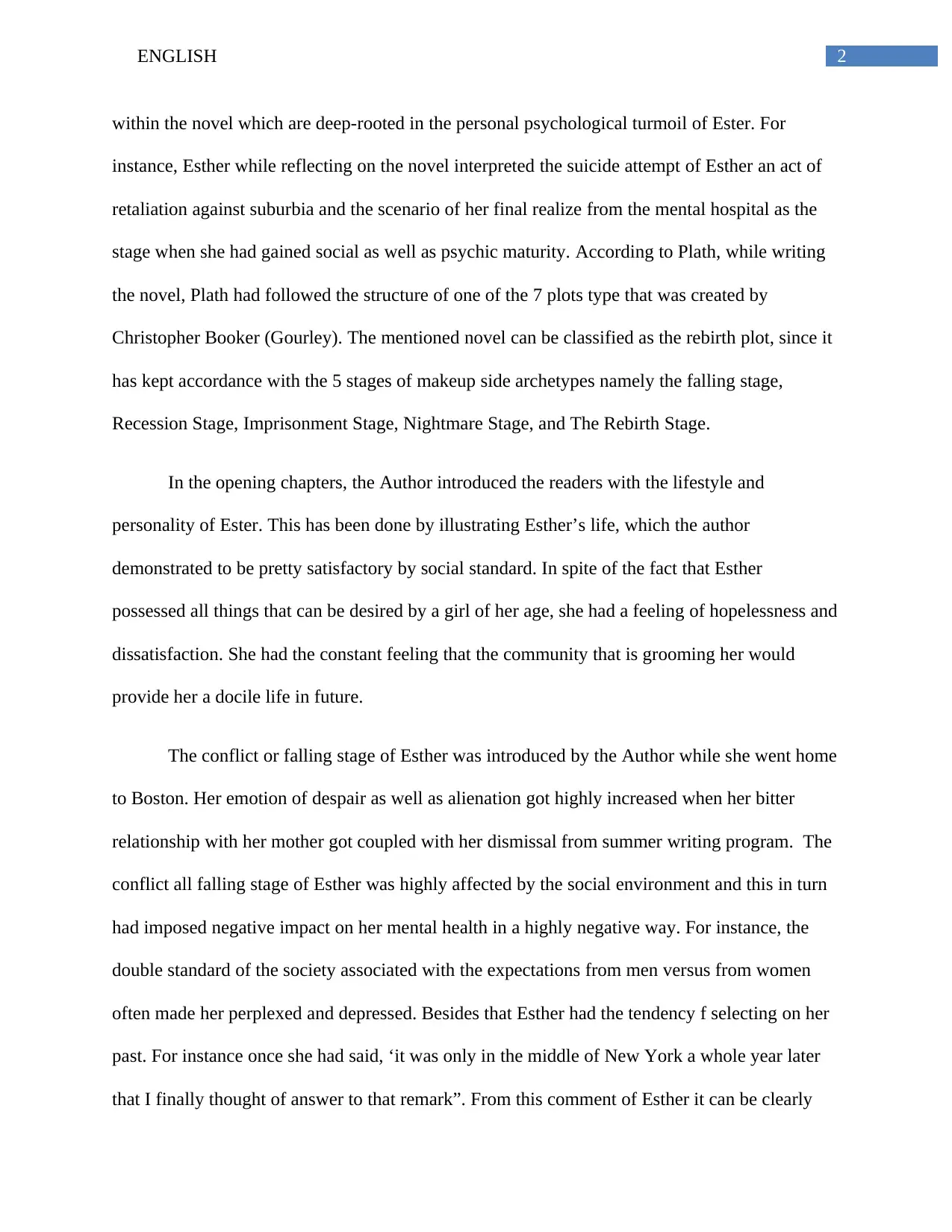
2ENGLISH
within the novel which are deep-rooted in the personal psychological turmoil of Ester. For
instance, Esther while reflecting on the novel interpreted the suicide attempt of Esther an act of
retaliation against suburbia and the scenario of her final realize from the mental hospital as the
stage when she had gained social as well as psychic maturity. According to Plath, while writing
the novel, Plath had followed the structure of one of the 7 plots type that was created by
Christopher Booker (Gourley). The mentioned novel can be classified as the rebirth plot, since it
has kept accordance with the 5 stages of makeup side archetypes namely the falling stage,
Recession Stage, Imprisonment Stage, Nightmare Stage, and The Rebirth Stage.
In the opening chapters, the Author introduced the readers with the lifestyle and
personality of Ester. This has been done by illustrating Esther’s life, which the author
demonstrated to be pretty satisfactory by social standard. In spite of the fact that Esther
possessed all things that can be desired by a girl of her age, she had a feeling of hopelessness and
dissatisfaction. She had the constant feeling that the community that is grooming her would
provide her a docile life in future.
The conflict or falling stage of Esther was introduced by the Author while she went home
to Boston. Her emotion of despair as well as alienation got highly increased when her bitter
relationship with her mother got coupled with her dismissal from summer writing program. The
conflict all falling stage of Esther was highly affected by the social environment and this in turn
had imposed negative impact on her mental health in a highly negative way. For instance, the
double standard of the society associated with the expectations from men versus from women
often made her perplexed and depressed. Besides that Esther had the tendency f selecting on her
past. For instance once she had said, ‘it was only in the middle of New York a whole year later
that I finally thought of answer to that remark”. From this comment of Esther it can be clearly
within the novel which are deep-rooted in the personal psychological turmoil of Ester. For
instance, Esther while reflecting on the novel interpreted the suicide attempt of Esther an act of
retaliation against suburbia and the scenario of her final realize from the mental hospital as the
stage when she had gained social as well as psychic maturity. According to Plath, while writing
the novel, Plath had followed the structure of one of the 7 plots type that was created by
Christopher Booker (Gourley). The mentioned novel can be classified as the rebirth plot, since it
has kept accordance with the 5 stages of makeup side archetypes namely the falling stage,
Recession Stage, Imprisonment Stage, Nightmare Stage, and The Rebirth Stage.
In the opening chapters, the Author introduced the readers with the lifestyle and
personality of Ester. This has been done by illustrating Esther’s life, which the author
demonstrated to be pretty satisfactory by social standard. In spite of the fact that Esther
possessed all things that can be desired by a girl of her age, she had a feeling of hopelessness and
dissatisfaction. She had the constant feeling that the community that is grooming her would
provide her a docile life in future.
The conflict or falling stage of Esther was introduced by the Author while she went home
to Boston. Her emotion of despair as well as alienation got highly increased when her bitter
relationship with her mother got coupled with her dismissal from summer writing program. The
conflict all falling stage of Esther was highly affected by the social environment and this in turn
had imposed negative impact on her mental health in a highly negative way. For instance, the
double standard of the society associated with the expectations from men versus from women
often made her perplexed and depressed. Besides that Esther had the tendency f selecting on her
past. For instance once she had said, ‘it was only in the middle of New York a whole year later
that I finally thought of answer to that remark”. From this comment of Esther it can be clearly
⊘ This is a preview!⊘
Do you want full access?
Subscribe today to unlock all pages.

Trusted by 1+ million students worldwide
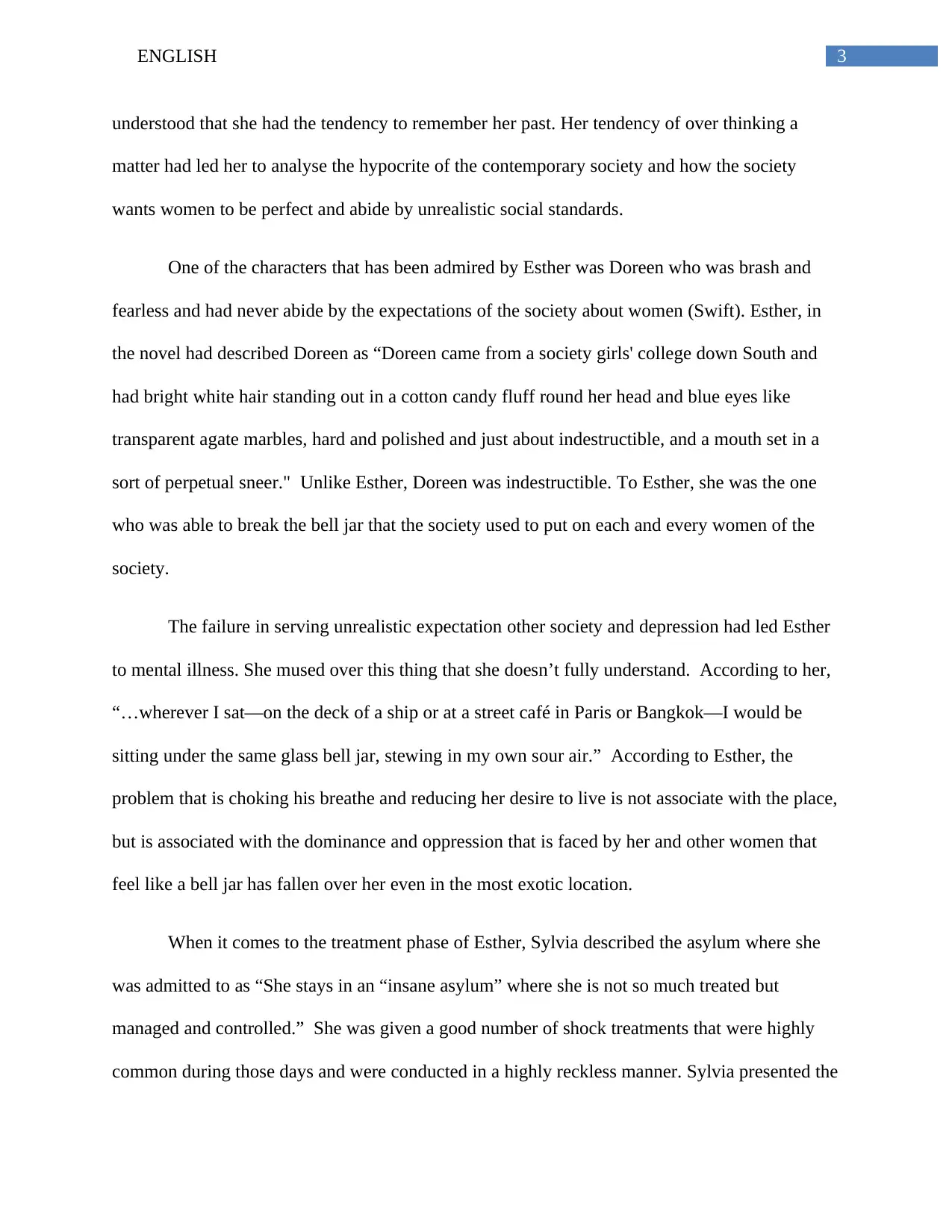
3ENGLISH
understood that she had the tendency to remember her past. Her tendency of over thinking a
matter had led her to analyse the hypocrite of the contemporary society and how the society
wants women to be perfect and abide by unrealistic social standards.
One of the characters that has been admired by Esther was Doreen who was brash and
fearless and had never abide by the expectations of the society about women (Swift). Esther, in
the novel had described Doreen as “Doreen came from a society girls' college down South and
had bright white hair standing out in a cotton candy fluff round her head and blue eyes like
transparent agate marbles, hard and polished and just about indestructible, and a mouth set in a
sort of perpetual sneer." Unlike Esther, Doreen was indestructible. To Esther, she was the one
who was able to break the bell jar that the society used to put on each and every women of the
society.
The failure in serving unrealistic expectation other society and depression had led Esther
to mental illness. She mused over this thing that she doesn’t fully understand. According to her,
“…wherever I sat—on the deck of a ship or at a street café in Paris or Bangkok—I would be
sitting under the same glass bell jar, stewing in my own sour air.” According to Esther, the
problem that is choking his breathe and reducing her desire to live is not associate with the place,
but is associated with the dominance and oppression that is faced by her and other women that
feel like a bell jar has fallen over her even in the most exotic location.
When it comes to the treatment phase of Esther, Sylvia described the asylum where she
was admitted to as “She stays in an “insane asylum” where she is not so much treated but
managed and controlled.” She was given a good number of shock treatments that were highly
common during those days and were conducted in a highly reckless manner. Sylvia presented the
understood that she had the tendency to remember her past. Her tendency of over thinking a
matter had led her to analyse the hypocrite of the contemporary society and how the society
wants women to be perfect and abide by unrealistic social standards.
One of the characters that has been admired by Esther was Doreen who was brash and
fearless and had never abide by the expectations of the society about women (Swift). Esther, in
the novel had described Doreen as “Doreen came from a society girls' college down South and
had bright white hair standing out in a cotton candy fluff round her head and blue eyes like
transparent agate marbles, hard and polished and just about indestructible, and a mouth set in a
sort of perpetual sneer." Unlike Esther, Doreen was indestructible. To Esther, she was the one
who was able to break the bell jar that the society used to put on each and every women of the
society.
The failure in serving unrealistic expectation other society and depression had led Esther
to mental illness. She mused over this thing that she doesn’t fully understand. According to her,
“…wherever I sat—on the deck of a ship or at a street café in Paris or Bangkok—I would be
sitting under the same glass bell jar, stewing in my own sour air.” According to Esther, the
problem that is choking his breathe and reducing her desire to live is not associate with the place,
but is associated with the dominance and oppression that is faced by her and other women that
feel like a bell jar has fallen over her even in the most exotic location.
When it comes to the treatment phase of Esther, Sylvia described the asylum where she
was admitted to as “She stays in an “insane asylum” where she is not so much treated but
managed and controlled.” She was given a good number of shock treatments that were highly
common during those days and were conducted in a highly reckless manner. Sylvia presented the
Paraphrase This Document
Need a fresh take? Get an instant paraphrase of this document with our AI Paraphraser
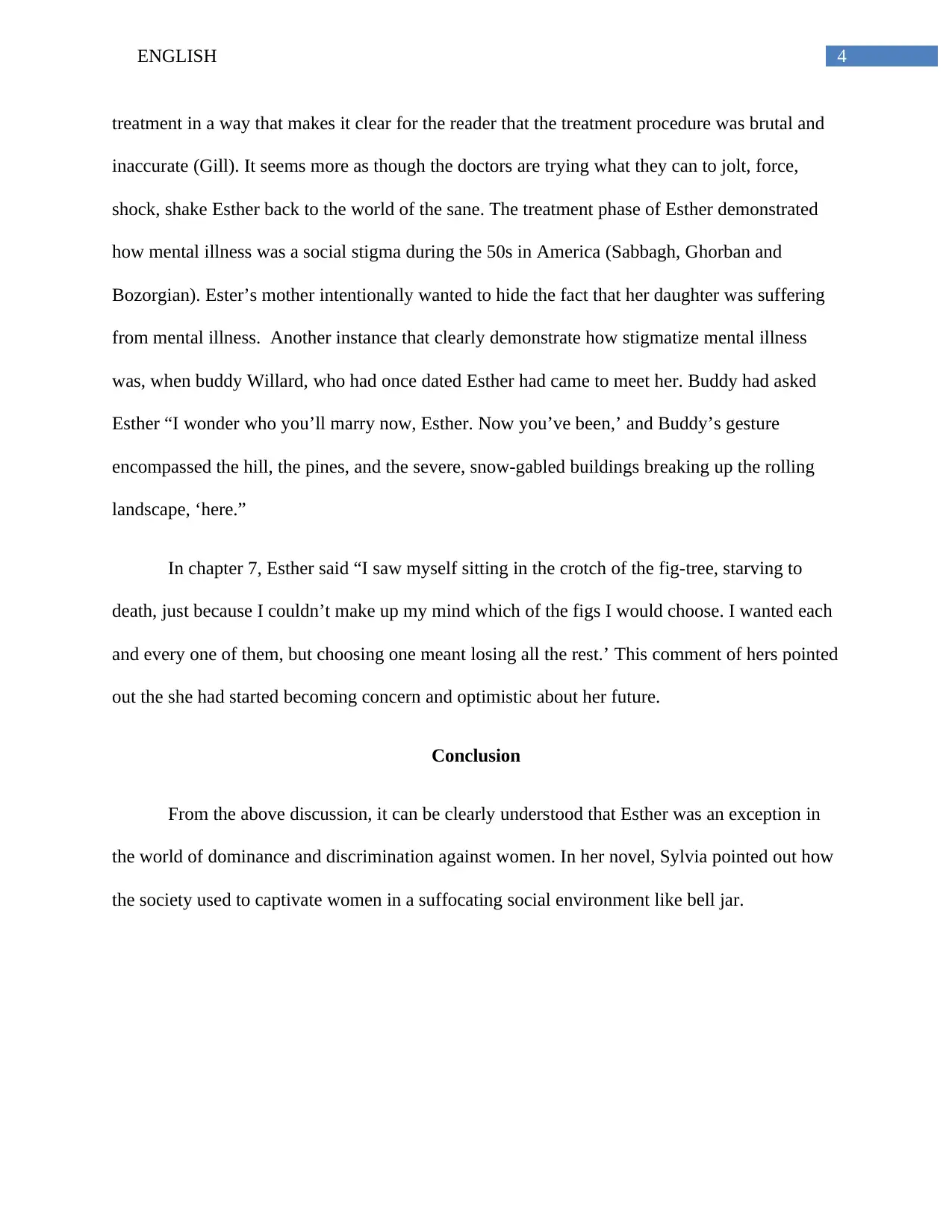
4ENGLISH
treatment in a way that makes it clear for the reader that the treatment procedure was brutal and
inaccurate (Gill). It seems more as though the doctors are trying what they can to jolt, force,
shock, shake Esther back to the world of the sane. The treatment phase of Esther demonstrated
how mental illness was a social stigma during the 50s in America (Sabbagh, Ghorban and
Bozorgian). Ester’s mother intentionally wanted to hide the fact that her daughter was suffering
from mental illness. Another instance that clearly demonstrate how stigmatize mental illness
was, when buddy Willard, who had once dated Esther had came to meet her. Buddy had asked
Esther “I wonder who you’ll marry now, Esther. Now you’ve been,’ and Buddy’s gesture
encompassed the hill, the pines, and the severe, snow-gabled buildings breaking up the rolling
landscape, ‘here.”
In chapter 7, Esther said “I saw myself sitting in the crotch of the fig-tree, starving to
death, just because I couldn’t make up my mind which of the figs I would choose. I wanted each
and every one of them, but choosing one meant losing all the rest.’ This comment of hers pointed
out the she had started becoming concern and optimistic about her future.
Conclusion
From the above discussion, it can be clearly understood that Esther was an exception in
the world of dominance and discrimination against women. In her novel, Sylvia pointed out how
the society used to captivate women in a suffocating social environment like bell jar.
treatment in a way that makes it clear for the reader that the treatment procedure was brutal and
inaccurate (Gill). It seems more as though the doctors are trying what they can to jolt, force,
shock, shake Esther back to the world of the sane. The treatment phase of Esther demonstrated
how mental illness was a social stigma during the 50s in America (Sabbagh, Ghorban and
Bozorgian). Ester’s mother intentionally wanted to hide the fact that her daughter was suffering
from mental illness. Another instance that clearly demonstrate how stigmatize mental illness
was, when buddy Willard, who had once dated Esther had came to meet her. Buddy had asked
Esther “I wonder who you’ll marry now, Esther. Now you’ve been,’ and Buddy’s gesture
encompassed the hill, the pines, and the severe, snow-gabled buildings breaking up the rolling
landscape, ‘here.”
In chapter 7, Esther said “I saw myself sitting in the crotch of the fig-tree, starving to
death, just because I couldn’t make up my mind which of the figs I would choose. I wanted each
and every one of them, but choosing one meant losing all the rest.’ This comment of hers pointed
out the she had started becoming concern and optimistic about her future.
Conclusion
From the above discussion, it can be clearly understood that Esther was an exception in
the world of dominance and discrimination against women. In her novel, Sylvia pointed out how
the society used to captivate women in a suffocating social environment like bell jar.
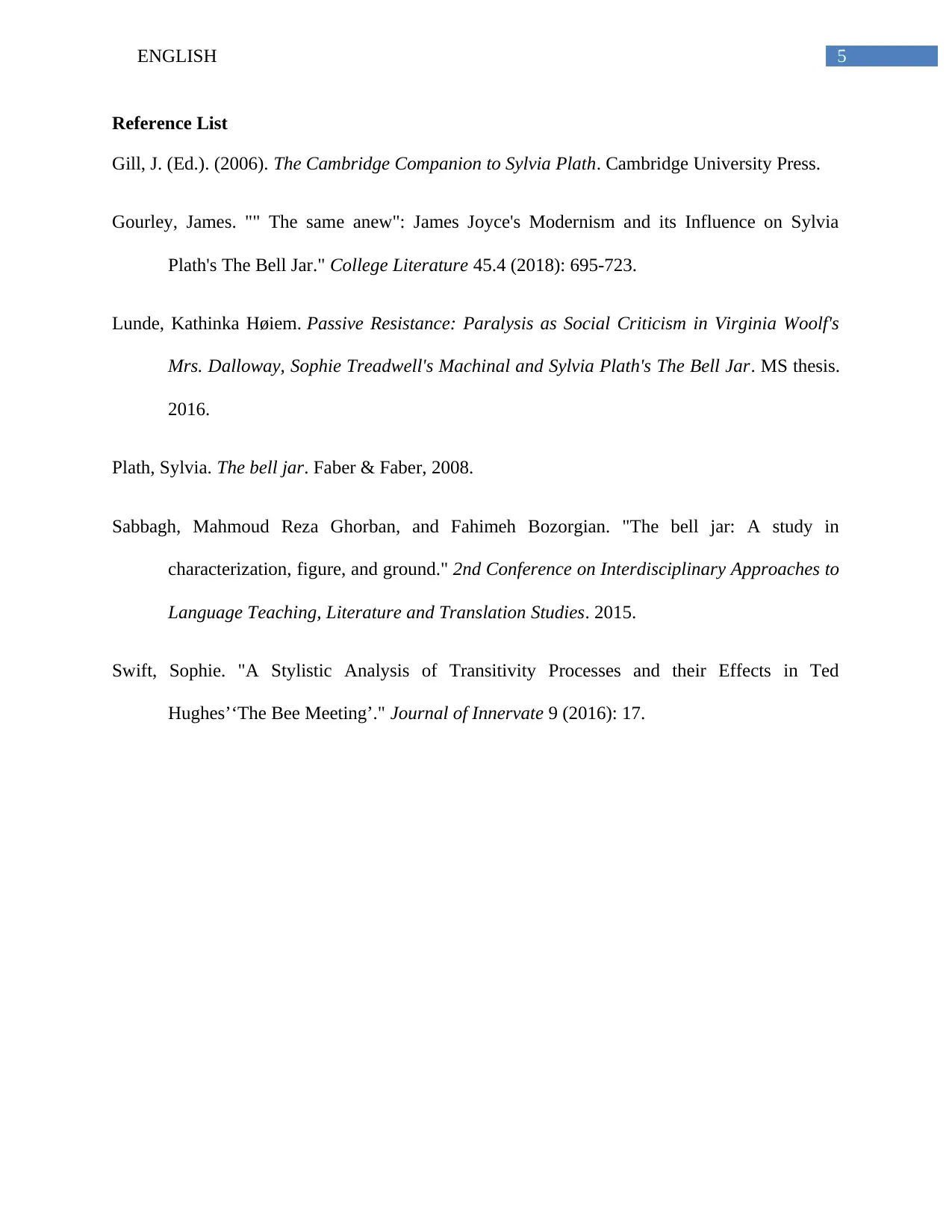
5ENGLISH
Reference List
Gill, J. (Ed.). (2006). The Cambridge Companion to Sylvia Plath. Cambridge University Press.
Gourley, James. "" The same anew": James Joyce's Modernism and its Influence on Sylvia
Plath's The Bell Jar." College Literature 45.4 (2018): 695-723.
Lunde, Kathinka Høiem. Passive Resistance: Paralysis as Social Criticism in Virginia Woolf's
Mrs. Dalloway, Sophie Treadwell's Machinal and Sylvia Plath's The Bell Jar. MS thesis.
2016.
Plath, Sylvia. The bell jar. Faber & Faber, 2008.
Sabbagh, Mahmoud Reza Ghorban, and Fahimeh Bozorgian. "The bell jar: A study in
characterization, figure, and ground." 2nd Conference on Interdisciplinary Approaches to
Language Teaching, Literature and Translation Studies. 2015.
Swift, Sophie. "A Stylistic Analysis of Transitivity Processes and their Effects in Ted
Hughes’‘The Bee Meeting’." Journal of Innervate 9 (2016): 17.
Reference List
Gill, J. (Ed.). (2006). The Cambridge Companion to Sylvia Plath. Cambridge University Press.
Gourley, James. "" The same anew": James Joyce's Modernism and its Influence on Sylvia
Plath's The Bell Jar." College Literature 45.4 (2018): 695-723.
Lunde, Kathinka Høiem. Passive Resistance: Paralysis as Social Criticism in Virginia Woolf's
Mrs. Dalloway, Sophie Treadwell's Machinal and Sylvia Plath's The Bell Jar. MS thesis.
2016.
Plath, Sylvia. The bell jar. Faber & Faber, 2008.
Sabbagh, Mahmoud Reza Ghorban, and Fahimeh Bozorgian. "The bell jar: A study in
characterization, figure, and ground." 2nd Conference on Interdisciplinary Approaches to
Language Teaching, Literature and Translation Studies. 2015.
Swift, Sophie. "A Stylistic Analysis of Transitivity Processes and their Effects in Ted
Hughes’‘The Bee Meeting’." Journal of Innervate 9 (2016): 17.
⊘ This is a preview!⊘
Do you want full access?
Subscribe today to unlock all pages.

Trusted by 1+ million students worldwide
1 out of 6
Related Documents
Your All-in-One AI-Powered Toolkit for Academic Success.
+13062052269
info@desklib.com
Available 24*7 on WhatsApp / Email
![[object Object]](/_next/static/media/star-bottom.7253800d.svg)
Unlock your academic potential
Copyright © 2020–2025 A2Z Services. All Rights Reserved. Developed and managed by ZUCOL.



